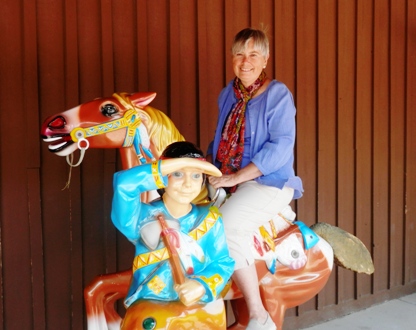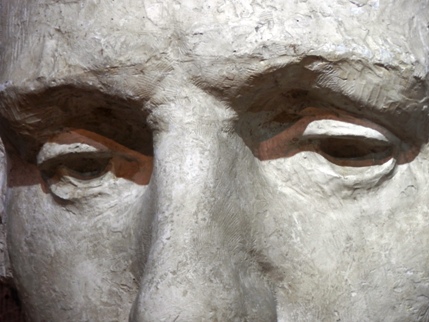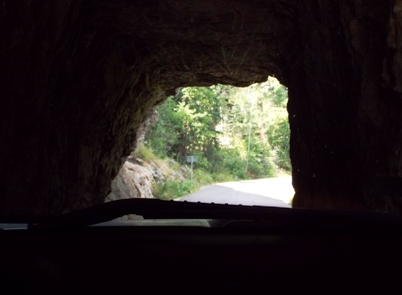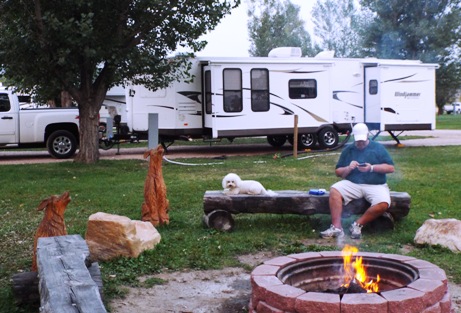The
"Wild West" image was built on a modicum of truth and a large dollop
of folklore and legend, where everybody and everything seemed larger than
life. Names like Wild Bill Hickok and
Calamity Jane are forever branded into our consciousness. Our recent eight state, 5,200 mile trek, which
we dubbed The Great Westward Ho! Adventure, allowed us to experience incredible
scenery and landscapes that were truly amazing and other-worldly. The Black
Hills, the Badlands and Devils Tower are natural vistas that seem anything but
natural. Man-made monuments such as Mount
Rushmore and Crazy Horse were (and are being) built on a grand scale that
reflects man's desire to transcend the ordinary.
One
town's creative method of enticing immigrants to the unsettled Dakota prairie
has stood as an icon since 1892. In an
effort to highlight the fertile productivity of the plains, Mitchell, SD created the Corn Palace. The Corn Palace is decorated inside and out
with more than 2,000 bushels of corn and forty tons of other grain. Every year it is stripped and redecorated with
a new theme.
 |
2,000 bushels of corn and 40 tons of other grains and grasses are used to decorate the
Corn Palace. College students are hired to do the work. They start in the spring and finish
just about harvest time. It takes 100 acres to grow all of the material used each year. |
 |
Local artists draw the pictures in white on black backgrounds, then indicate what colors
to put into each section, much like a giant paint-by-number picture. 275 thousand ears
of corn in 12 natural colors are split in half lengthwise and nailed up to make the murals |
The
Dakota Indians use the phrase "mako sica" (literarily "land bad") to describe
a topography of barren landscape with deep gorges and lunar-like spires. Today 244,000 of those acres are part of the
Badlands National Park. This area was
once part of a huge salt sea whose floor was pushed up by volcanic
activity. Millions of years of wind,
rain, and snow erosion has created a breathtakingly eerie landscape.
 |
In January 1939, President Franklin Roosevelt signs a proclamation creating the
Badlands National Monument. In November 1978, Congress passes
legislation re-designating the Badlands as a National Park |
 |
The rock formations are the result of eons of erosion. Today, the rock is eroding at
the rate of about one inch per year. |
 |
| This sign caught our attention as we entered Badlands National Park |
 |
Prairie Dogs are cute, but are a nuisance to ranchers. Livestock can break legs
stepping in their holes. And now, with the added threat of plague... |
 |
The 1928 bill authorizing the creation of a park here used the name Teton
National Park in an effort to avoid the negative-sounding name Badlands. The
name Teton National Park was later given to the park near Jackson, WY. |
 |
During WWII, the government took over a portion of the Pine Ridge Reservation
that now lies within the National Park, and used the land to test new artillery
there from 1942 to 1945 |
On
the north edge or "wall" of the Badlands is America's #1 roadside attraction. Wall Drug has been part of the Wall community
since 1931. Ted and Dorothy Hustead were
looking for a drugstore to purchase in a small community with a Catholic
church. The town of Wall (population
365) met their requirements. The family eked
out a living for five years - it was, after all, the Great Depression - before
Dorothy came up with the idea of "free ice water" to entice travelers
to stop at their store. The popular ice
water give-away, a campaign that placed billboards across South Dakota, and friendly
service built their drugstore's reputation into a must-see attraction that
today boasts 20,000 visitors on any summer day!
 |
In addition to a 520-seat restaurant, Wall Drug has a whole mall of shops, ice cream
parlor, drug store -- you name it, they probably have it. The restaurant houses
the largest private collection of western and illustration art in the country |
 |
The "Backyard" houses a video arcade and a whole collection of
photo op props. Yvonne is taming a South Dakota "Jack-a-lope" |
 |
We heard about a woman in Yellowstone getting gored when she tried to take
a "selfie" with a bison. Mike said there is nothing to it, if you do it right. |
 |
A painted Indian pony, a Native American scout...the "Backyard"
at Wall Drug can make you feel like a kid again |
About
an hour west of the Badlands lie the Black Hills. The picturesque town of Hill City, SD marks
the gateway to amazing engineering feats and magnificent natural vistas.
Mount
Rushmore was envisioned by sculptor Gutzon Borglum as a national memorial to
honor the American philosophy and spirit. Between October 4, 1927 and October 31, 1941, Borglum
and four hundred workers created this masterpiece. During the fourteen years that it took to
complete the monument, only six years were spent in actual carving. Raising funds and dealing with political
issues caused long delays in the effort.
 |
| Seeing the faces on the mountain for the first time literally takes your breath away |
 |
The Avenue of Flags. There are 56 flags displayed, representing 50 states, the
District of Columbia, 3 Territories and 2 Commonwealths of the United States |
 |
I love this photo...a very powerful and moving photo of
George Washington's eyes |
 |
This view of the monument was taken from the site of the artist's studio.
Borglum said that in his opinion, this was the best view of Mt. Rushmore |
 |
As you leave Mt. Rushmore, a view to your right
shows George Washington in profile |
 |
| Our campsite at Rafter J Bar Ranch near Hill City - - a wonderful campground |
Seventeen
miles from Mount Rushmore in the Southern Black Hills is another astounding
sculpture in progress. Crazy Horse, a Lakota
Sioux warrior, is being immortalized on the face of Thunderhead Mountain. The
project was initiated by Chief Henry Standing Bear (Oglala Sioux) who contacted
sculptor Korczak Ziolkowski to create a monument to celebrate that "...the
Red Man has great heroes too." The
eighty-seven-and-a-half foot tall face of Crazy Horse was finished in 1998 - fifty
years after construction began. The statue is an on-going project and the
Ziolkowski family is still integrally involved.
 |
This is the artist's mock-up of the sculpture. It is located at the Visitors' Center.
Look under his arm and you can see the face of the actual sculpture, one mile away |
 |
Crazy Horse's head, 50 years in the making. The hole in the mountain is the
beginning of the space under his arm (see the mock-up in the previous picture) |
 |
| Close-up of the face, with scaffolding on the top of the head |
 |
In the Crazy Horse Museum, a statue of a horse dressed in
beautiful and very intricate beaded tack |
 |
| Just 'cause I love flowers and find bees on them interesting |
Amazing
spires create scenes of wonder. Taking the Needles Highway, the traveler gazes
in awe at the jagged natural sculptures and holds his or her breath as the road
passes through tunnels that require the mirrors to be pulled in against the
vehicle.
 |
| The view along Needles Highway |
 |
| Don't try to take your RV on Needles Highway |
 |
One of 6 tunnels along Needles Highway. Most are barely wide enough to get
a car through. We had to pull in the mirrors on our truck a couple of times |
 |
| Coming out of one of the 8' 4" wide tunnels |
 |
Custer State Park, near the Crazy Horse memorial. This bison was laying
within 10 feet of the road |
 |
| Pronghorn deer, Custer State Park, South Dakota |
To
the north and west of Mt. Rushmore, quaint towns await exploration - - one
founded on mining but famous for gambling; the other famous (some might say
notorious) for an annual event known as "Bike Week." Both, in their own way, keep the spirit of
the old west alive.
 |
The original Main Street in Deadwood, SD...now hotels, casinos, restaurants,
bars and shops. Four times each day, there is a shoot-out on this street |
 |
It is said that Hickock was holding two pairs - aces and eights - in a poker game
when he was killed. The fifth card in the "Dead Man's Hand" was a jack by some
accounts, a nine by other accounts, and some say he didn't have a fifth card. |
 |
Wild Bill Hickock's grave in Mount Moriah Cemetery in Deadwood, SD
Calamity Jane (real name Martha Jane Cannary) is buried beside him. |
 |
Sturgis is a quiet little town most of the year, but for the 75th Anniversary Rally in
August 2015, the number of motorcycles was estimated at one million. The
previous record was 633,000, set during the 60th Anniversary Rally in 2000 |
 |
The Full Throttle Saloon, setting for a reality TV show that ran on cable for
a couple of seasons, bills itself as the largest biker bar in the world |
Heading
into Wyoming, a massive 875 foot magma pillar dominates the landscape. Devils Tower
is a sacred place to the Lakota and other tribes. In 1906 President Teddy Roosevelt dedicated
Devils Tower as the nation's first National Monument.
 |
Devils Tower rises 875 feet from its base to the summit,
and stands 1,267 feet above the Belle Fourche River |
 |
Checking into the Devils Tower KOA, just outside the entrance to the national
monument. Close Encounters of the Third Kind was filmed on location here, and
the KOA shows the film each evening, outdoors, with the Tower as a backdrop |
 |
On the proclamation signed by President Roosevelt, the apostrophe in Devil's
Tower was left out, and never corrected, so the "official" name is Devils Tower |
 |
| Yvonne and Mike and Adrienne and Ralph at the base of Devils Tower |
 |
A lot of climbers scale the Tower. No guide is required, but all climbers must register
with the Rangers. A voluntary "no climbing" period is observed each June as Native
Americans gather at the Tower, which they believe is sacred ground. |
 |
The top of the Tower was first reached by two local cowboys, who attached a wooden
ladder system to the side of the Tower. Remnants of the ladders can still be seen |
 |
| Checking email at the campfire at Devils Tower KOA. Sophie is pretty relaxed, too. |
Another
national monument of a more sobering nature is located on the Montana prairie,
near the little community of Garryowen. The
Little Bighorn Battlefield National Monument commemorates the defeat and death
of Lt. Col. George Armstrong Custer and 263 soldiers of the 7th Cavalry in
1876. In recent years the monument has
acknowledged and included information about the Plains Indians, their efforts
to maintain and eventually the loss of their traditional way of life.
 |
| Into Montana...there is a whole lot of open land out here. |
 |
Last Stand Hill at Little Bighorn Battlefield. The stones mark the spots where the
soldiers of the 7th Cavalry fell. Note the stone with the black plaque on it. |
 |
This stone marks the spot where George Custer's body was recovered.
Custer is buried in the cemetery at West Point in New York. |
 |
Other than the graves in Arlington National Cemetery, this is the only other officially
recognized Tomb of an Unknown Soldier, a trooper who died in the battle of Little
Bighorn, whose body was later found. This grave is on private property. |
 |
| The Custer National Cemetery at Little Bighorn Battlefield |
 |
The grave of Two Whistles, a Crow Indian who was
a scout for George Custer. He survived the battle
and died in 1929 at the age of 73 |
 |
A glorious sunset viewed from our campsite at 7th Ranch RV Camp
near Garryowen, MT |
 |
The sun is just about ready to slip from view. Mike said that as he watched it,
he wondered if any of Custer's men watched the sun set on June 24, 1876,
not realizing that it would be the last one they would ever see |
 |
Keep in mind, when you travel, that you are likely to
encounter at least one ass out on the road! |